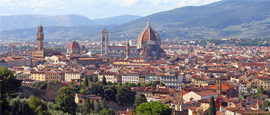Florence History
Although there were settlements dating back to the Etruscans and beyond, Florence itself was founded in 59 BC by the Romans. ‘Florentia’ was established for war veterans and built in the grid-style of a military camp. It served as the main route between Rome and the north, which enabled it to rapidly expand as a commercial centre.
Florence owes much of its wealth to the Middle Ages when banking boomed on the back of the city’s profitable cotton trade. In 1235, Florence minted the florin, the first gold coin to become standard currency across Europe.
In the 14th and 15th centuries, Florence was a city republic governed by an oligarchy of elite merchant and banking families. However, popular revolts led to periods when public office was also shared among citizens from the middle and lower artisan classes.
Although internal feuds were frequent, commissions from the rich resulted in a near-unparalleled era of art and architecture. The names Strozzi, Rucellai and Pitti can be found all over Florence, but it was the Medici family (who led the city for three centuries) that nurtured the likes of Botticelli and Michelangelo. This was also the period of Dante (the father of the Italian language) and Savonarola's Bonfire of the Vanities.
The culmination of the Medici line led to Austrian control of the city and other Tuscan territories in 1737. After a period of Napoleonic rule from 1797, Florence passed back to Austria, until the region was unified with the new Italian state in 1861. For a time it was the capital, before Rome superseded it. The city was modernised, with Piazza della Repubblica widened and a large triumphal arch constructed at the west end.
In the 19th century the population of Florence doubled and then it tripled in the 20th century with the growth of tourism and trade. In 1944, nearly all the city’s bridges were destroyed by the Nazis in an attempt to stall the Allied advance.
Did you know?
• The only bridge in Florence’s historic centre not to be destroyed by the Nazis during WWII was Ponte Vecchio. Hitler himself is said to have vetoed its destruction at the last moment because it was too beautiful.
• Florence was given to former soldiers as a settlement by Julius Caesar in the 1st century BC.
• In 1966, the city was flooded, damaging much of its precious architecture. It is said that the authorities had advance warning of the bursting of the River Arno’s banks but failed to tell the people.
Do you have any Feedback about this page?
© 2025 Columbus Travel Media Ltd. All rights reserved. No part of this site may be reproduced without our written permission, click here for information on Columbus Content Solutions.




 You know where
You know where